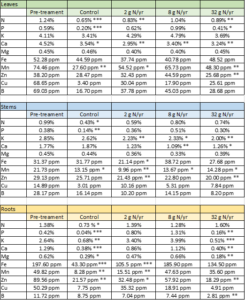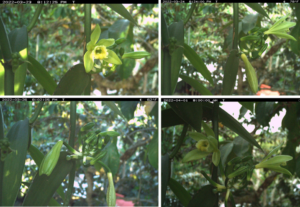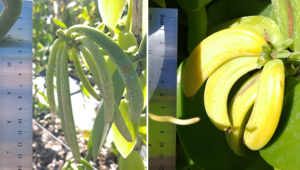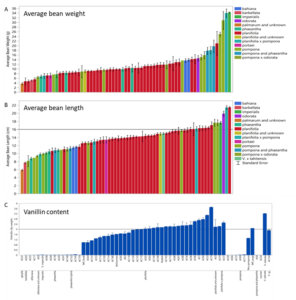Final report for GS21-238
Project Information
Vanilla has the potential to be the highest-grossing agricultural commodity per acre available to growers in Florida, Hawaii, and Puerto Rico, but foundational strategies for cultivation are lacking. Vanilla is the vining orchid species that produces vanilla “beans” (seed capsules) from which natural vanilla extract is produced. Management practices of domestic vanilla production have not yet been developed. Since there is a nearly insatiable demand for natural vanilla extract, the USA being the largest importer, domestic growers located in favorable growing climates could greatly benefit from diversifying their agribusiness with this alternative crop. Therefore, responding to and supporting the rising interest in the crop, we propose developing responsible guidelines for vanilla production in the subtropical United States.
As a new crop, growing recommendations are necessary to prevent the overuse of chemical inputs, decrease costs, and harvest a uniform high-quality crop; all of which sustains farms’ economic viability and will establish a sustainable mindset during the early stages of vanilla adoption. One of the highest production costs (~40%) is manual pollination, but natural pollinators have only been minimally investigated. The promotion of natural pollinators could provide a significant economic benefit and at the same time incentivize reduced pesticide. Data for the comparison of different cultivars has yet to be made available. Publishing cultivar characteristics would allow growers to choose the highest yielding and best quality types that are best fit for their growing system. Through these efforts, we hope to contribute to enhanced grower profitability, improved yields, and reduced chemical inputs.
- Develop input recommendations for conventional and organic vanilla nutrition management.
This first objective tests the efficacy of conventional and organic fertilizer rates on plant growth. Internationally, vanilla is commercially cultivated by most small acreage farmers without the input of any fertilization; however, this is unlikely to be the adopted strategy for domestic growers. Facilitating both organic and conventional cultivation will provide growers with options to meet their target markets. This objective will be met with two one-year experiments. First, an idea of the crop nutritional requirements for vanilla will be established, and second, a test of conventional and organic fertilizer sources will be performed. For the first experiment a Florida-adapted micro-propagated clone, V. planifolia 'Painter', will be established in 1-gallon pots with 14 treatments covering a range of nitrogen, phosphorous, and potassium application rates. The second experiment will be designed to have conventional and organic fertilizer treatments matching the optimum nitrogen rate based on the results of the first experiment. Plant growth rates will be recorded every two to six months to determine the optimal fertilization regimes. All treatments will be statistically evaluated using ANOVA and Tukey's T-test of honest significant difference (HSD) in the R statistical software.
- Discover and promote native pollination of vanilla.
The second objective is to discover which insects act as native vanilla pollinators in South Florida. We will collaborate with an entomologist, local farmer, and local park biologists to plan the locations and times for observing pollinator activity. We plan to use camera traps to record pollinator visits and quantify the number of pollinators visiting flowers and identify the pollinator species. If possible, a small sample of pollinators will be captured to confirm identification and for photography records. A sub-objective will be to describe as best as possible the environment that promotes the habitation of the targeted pollinators. On-farm and natural environment observations will be done in year one and if an appropriate pollinator is found, in year two we will attempt to acquire, attract, and house as possible the pollinators in a shade house environment. Camera traps will then be used to verify pollinator patronage to vanilla flowers in the shade house.
- Generate phenotypic data for potential commercial vanilla accessions.
This last objective is to generate yield and quality information to rank the potential of accessions for commercial production. The primary determinant of vanilla extract quality is the abundance of vanillin in vanilla extract, which can be quantified using High-Performance Liquid Chromatography (HPLC). Other plant and bean traits essential for vanilla production include disease prevalence, bean length, bean diameter, number of beans per raceme, weight of cured beans, and aroma-flavor composition of cured bean extracts. This project leverages the vanilla germplasm collection at TREC. All traits will be evaluated individually in the software R and accessions will then be ranked accordingly to select appropriate high-performing genotypes.
Cooperators
- (Researcher)
- (Educator and Researcher)
- (Educator and Researcher)
Research
Objective 1. Develop input recommendations for conventional and organic vanilla nutrition management
Two experiments were originally proposed for this objective to 1) develop a crop nutritional requirement (CNR) and 2) assess organic and conventional applications. However, the extreme weather conditions and virus infection has constantly impacted the experiments in 2021 and 2022. Since the domestic production of vanilla will likely be in conventional system, this objective was repurposed to focus on the nutrition management of vanilla. As little information is known on vanilla cultivation, the use of nitrogen was explored under this objective.
The experiment focusing on the nitrogen use of vanilla was first established at the University of Florida Tropical Research and Education Center (TREC) in Homestead, Florida in Spring 2023. Three treatments (2, 8 and 32 g N/plant/year) and a control group were applied to the vanilla plant and data were collected on the plant height, leaf number and leaf greenness (indicated by SPAD). Eight plants were used for each treatment with additional three plants for pre-treatment nutrient analysis. The treatments were administered monthly. Uniform phosphorus (3 g/plant/year) and potassium (9 g/plant/year) were applied to all plant to meet the nutrient needs. For each nutrient survey, plants were partitioned into three types (roots, stems, and leaves) for macro- and micro- nutrient analysis. Due to the nature of destructive harvest, data collection was carried out quarterly. All treatments were statistically evaluated using T-tests to determine the optimal nitrogen requirement for vanilla cultivation.
Objective 2. Discover and promote native pollination of vanilla
This objective was to identify the insects act as native vanilla pollinators. Vanilla plants were observed to set fruits without human intervention and presumably pollinated by natural insects. In collaboration with the entomologist and local park biologists, motion sensor camera traps were set up at Pine Island (Lee County) to record pollinator visits and quantify the number of pollinator visits, length of visit, and the number of flowers visited per pollinator in 2022. The experiment setup was terminated due to Hurrian Ian. The experimental site has been destroyed by the Hurrian which makes this experiment unrepeatable.
Objective 3. Generate phenotypic data for potential commercial vanilla accessions.
Elite plant germplasm is the key for new agriculture crop development. This is especially critical for high value crops such as vanilla. Vanilla is often vegetatively propagated throughout the world and has not benefit from modern breeding. Unique accessions adapt to Florida environment condition are important to establish a domestic vanilla industry. The most important agronomic trait of vanilla is the concentration of vanillin, the major flavor compound in vanilla extracts. UF TREC hosts a large vanilla collection encompassing over 200 accessions. This objective was to generate yield and quality information to rank the potential of accessions for commercial production.
Vanilla flowers were manually pollinated in each accession to generate individual beans in 2021 and 2022. The beans were harvested when reached to maturity. Phenotypical data such as bean length, weight and diameter were taken for each individual bean before curation. After curation, the beans went through the extraction process using a customized protocol. The vanillin content was quantified using isotope-based LC-MS/MS. The standard curve was generated with 8 levels of higher concentrations and 6 level of lower concentrations. Each concentration contains 0.2 mg/L vanillin as internal standard and replicated three times.
Objective1 : Develop input recommendations for optimized nitrogen use in vanilla.
The average growth data of plant height, number of leaf and SPAD indicate the strong growth of vanilla plant treated at the rate of eight gram of nitrogen per year (Table 1). Statistical analysis of nutrient distribution showed the eight-gram treatment group was the closest group compared to pre-treatment group (least significant difference) (Table 2). These detailed insights provide an understanding of how varying nitrogen levels impact diverse plant growth characteristics, emphasizing the need for precise nitrogen management strategies in agricultural practices.
Table 1: Summary of plant growth indicators under nitrogen treatments
|
Treatment |
Height |
Leaf No. |
SPAD |
|
Control |
81.35 |
16.00 |
29.46 |
|
2g N |
86.96 |
16.04 |
28.60 |
|
8g N |
95.12 |
19.55 |
30.87 |
|
32g N |
74.96 |
14.75 |
29.17 |
Table 2. T-test of nutrient analysis under three nitrogen treatment
Pr > |t| levels. * = 0.05; ** = 0.01; *** = 0.001
Objective 2. Discover and promote native pollination of vanilla
Despite the impact of Hurricane Ian, we were still able to acquire images from the camera to capture movement activities around the vanilla flowers. Flower time and duration were captured (Figure 1). Potential pollination was observed from the picture but could not be confirmed due to the loss of the plant. A computer algorithm is needed to analyze those images in order to identify the potential insects for pollination, the number of pollinator visits, length of visit, and the number of flowers visited. Image data have been shared with collaborator to develop algorithm for this objective.
Figure 1. Time-lapse image of a single vanilla flower raceme in four different days.
Objective 3. Generate phenotypic data for potential commercial vanilla accessions
A total of 100 vanilla accessions were harvested and evaluated for bean weight and length. Of them, 55 accessions were used to extract vanillin and compared with commercial standards. Morphological diversity was observed between the beans of two most common commercial vanilla species, Vanilla planifolia and V. pompona (Figure 2). Phenotypic diversity was observed within V. planifolia accessions (Figure 3). Several V. planifolia accessions showed much higher vanillin content than the average vanilla content of vanilla beans (2%) in commercial market (Figure 3C). Phenotypic diversity was also observed within V. pompona accessions (Figure 3). Hybrids between the two commercial species has showed greater bean length, weight, and vanillin content.
Figure 2. Vanilla capsules from Vanilla planifolia (left) and V. pompona (right).
Figure 3. Phenotypic variation of vanilla collection. A) average bean weight, B) average bean length, and C) vanillin content.
Educational & Outreach Activities
Participation Summary:
In April 2023, we organized an in-person vanilla symposium workshop to share knowledge of vanilla history, cultivation, and breeding. A total of 55 audience including agriculture professional, potential growers, researchers, agriculture specialists, students, and plant hobbyist attended this workshop, of which 80% of audience has reported knowledge gain. A vanilla presentation was given at the 2023 ASHS conference in Orlando. We have produced one vanilla extension publication under this project and an additional publication is in preparation with the purpose of disseminating the knowledge to a broader audience.
Project Outcomes
This is the first experiment of nutrient management on vanilla cultivation in conventional system. We have identified the nutrient baseline and a preferred nitrogen requirement of vanilla. However, more experiments are needed for optimization and the requirement of other nutrient needs. Study on potential pollinator identification was interrupted by weather conditions but natural pollination has been observed on vanilla flower in Florida. The on-going image processing may lead to the identification of potential pollinators. The phenotypic data collected from the UF TREC vanilla collection will serve as an important source for future breeding projects.
The experiments of first objective failed several times due to the lack of basic knowledge on this crop. We had to rethink and repurpose the objective goal to fill the knowledge gap, which was a great success. The idea of pollinator identification was success even the experiment went through extreme weather condition and was interrupted. However, the large amount of image process slowed down the entire process. Strategic thinking is needed when propose such idea in the future.
Vanilla is a high value specialty crop with great potential for tropical agriculture area. Like many other new crop, little information is known about the best management practices, the insect/pest management, and genetics of this crop. More research is needed to understand this crop for future large scale commercial production.



